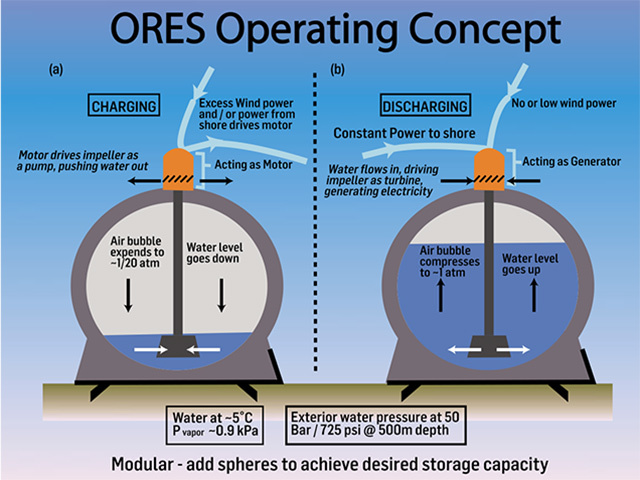
There is no doubt that offshore wind could provide abundant electricity. But, as with solar energy, this power supply can be intermittent and unpredictable.
A variety of energy storage solutions have been offered to solve this issue, though none have made it into reality, or at least not yet.
The latest idea comes from a team of researchers at MIT who propose the construction of giant concrete spheres that would capture the energy from surplus electricity production.
They would be deployed in association with floating turbines, weigh thousands of tonnes apiece and act as anchors for the turbine pontoons.
Whenever the wind turbines produce more power than is needed, that power would be diverted to drive a pump attached to the underwater structure, pumping seawater from a 30m-diameter hollow sphere.
Later, when power is needed, water would be allowed to flow back into the sphere through a turbine attached to a generator, and the resulting electricity sent back to shore.
The MIT team has calculated that just one such 25m sphere sunk in 400m of water could store up sufficient energy to generate 6-megawatt-hours of power. The optimal installation depth is said to be 750m.
They claim that 1,000 such spheres could supply as much power as a nuclear plant for several hours – enough to make them a “reliable source of power”.
The 1,000 wind turbines that the spheres could anchor could, on average, replace a conventional on-shore coal or nuclear plant.
And, unlike nuclear or coal-fired plants, which take hours to ramp up, this energy source could be made available within minutes, and then taken offline just as quickly; rather like hydro-power.
The MIT team suggests too that the system could be grid-connected, so the spheres could also be used to store energy from other sources, including solar arrays on shore, or from base-load power plants, which operate most efficiently at steady levels. This could potentially reduce reliance on peak-power plants, which typically operate less efficiently.
The weight of concrete and steel in the spheres’ 3m-thick walls would be sufficient to keep the structures on the seafloor even when empty, they say. They would be cast on land and then towed out to sea on barges.
They say that no existing vessel has the capacity to deploy such a large load, a claim that puzzles Energy given the heavy-lift capabilities of the offshore oil and gas industry.
It is claimed too that a storage sphere could be built and deployed at a cost of about $12million and that cost reduction with experience is possible.
Various floating turbine ideas have been mooted on both sides of the Atlantic. The one cited by the MIT sphere team is a concept developed by colleague Paul Sclavounos, a professor of mechanical engineering and naval architecture.
Jim Eyer, a senior analyst with E & I Consulting in California, says the concept “addresses some important challenges associated with wind generation”, that it is “novel” but that proof of concept would be required.
So far, the MIT team built a 760mm (30-inch) diameter prototype in 2011, which is said to have worked well through charging and discharging cycles, demonstrating the feasibility of the idea.
The team hopes to extend its testing to a 3m sphere, and then scale up to a 10m version to be tested in an undersea environment, if funding becomes available.
MIT has filed for a patent on the system.
Recommended for you
